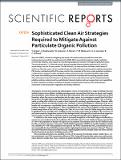| dc.contributor.author | Grigas, Tomas | |
| dc.contributor.author | Ovadnevaite, Jurgita | |
| dc.contributor.author | Ceburnis, Darius | |
| dc.contributor.author | Moran, E. | |
| dc.contributor.author | McGovern, F.M. | |
| dc.contributor.author | Jennings, Stephen G. | |
| dc.contributor.author | O'Dowd, Colin | |
| dc.date.accessioned | 2018-02-14T15:02:33Z | |
| dc.date.available | 2018-02-14T15:02:33Z | |
| dc.date.issued | 2017-03-17 | |
| dc.identifier.citation | Grigas, T., Ovadnevaite, J., Ceburnis, D., Moran, E., McGovern, F. M., Jennings, S. G., & O’Dowd, C. (2017). Sophisticated Clean Air Strategies Required to Mitigate Against Particulate Organic Pollution. Scientific Reports, 7, 44737. doi: 10.1038/srep44737 | en_IE |
| dc.identifier.issn | 2045-2322 | |
| dc.identifier.uri | http://hdl.handle.net/10379/7136 | |
| dc.description.abstract | Since the 1980's, measures mitigating the impact of transboundary air pollution have been implemented successfully as evidenced in the 1980-2014 record of atmospheric sulphur pollution over the NE-Atlantic, a key region for monitoring background northern-hemisphere pollution levels. The record reveals a 72-79% reduction in annual-average airborne sulphur pollution (SO4 and SO2, respectively) over the 35-year period. The NE-Atlantic, as observed from the Mace Head research station on the Irish coast, can be considered clean for 64% of the time during which sulphate dominates PM1 levels, contributing 42% of the mass, and for the remainder of the time, under polluted conditions, a carbonaceous (organic matter and Black Carbon) aerosol prevails, contributing 60% to 90% of the PM1 mass and exhibiting a trend whereby its contribution increases with increasing pollution levels. The carbonaceous aerosol is known to be diverse in source and nature and requires sophisticated air pollution policies underpinned by sophisticated characterisation and source apportionment capabilities to inform selective emissions-reduction strategies. Inauspiciously, however, this carbonaceous concoction is not measured in regulatory Air Quality networks. | en_IE |
| dc.description.sponsorship | The research leading to these results has received funding from the European Union’s Seventh Framework Programme (FP7/2007–2013) project BACCHUS under grant agreement n°603445, the Irish Environmental Protection Agency, the HEA PRTLI4 project. | en_IE |
| dc.format | application/pdf | en_IE |
| dc.language.iso | en | en_IE |
| dc.publisher | Nature Publishing Group | en_IE |
| dc.relation.ispartof | Scientific Reports | en |
| dc.rights | Attribution-NonCommercial-NoDerivs 3.0 Ireland | |
| dc.rights.uri | https://creativecommons.org/licenses/by-nc-nd/3.0/ie/ | |
| dc.subject | UNITED-STATES | en_IE |
| dc.subject | AEROSOL | en_IE |
| dc.subject | MORTALITY | en_IE |
| dc.subject | ATMOSPHERE | en_IE |
| dc.subject | PARTICLES | en_IE |
| dc.title | Sophisticated clean air strategies required to mitigate against particulate organic pollution | en_IE |
| dc.type | Article | en_IE |
| dc.date.updated | 2018-02-14T11:08:34Z | |
| dc.identifier.doi | 10.1038/srep44737 | |
| dc.local.publishedsource | http://dx.doi.org/10.1038/srep44737 | en_IE |
| dc.description.peer-reviewed | peer-reviewed | |
| dc.contributor.funder | European Union’s Seventh Framework Programme (FP7/2007–2013) | |
| dc.contributor.funder | Environmental Protection Agency | |
| dc.contributor.funder | HEA PRTLI4 | |
| dc.internal.rssid | 12472648 | |
| dc.local.contact | Darius Ceburnis, School Of Physics, Room 215a Arts/Science Building, Nui Galway. 2496 Email: darius.ceburnis@nuigalway.ie | |
| dc.local.copyrightchecked | Yes | |
| dc.local.version | PUBLISHED | |
| nui.item.downloads | 292 | |


